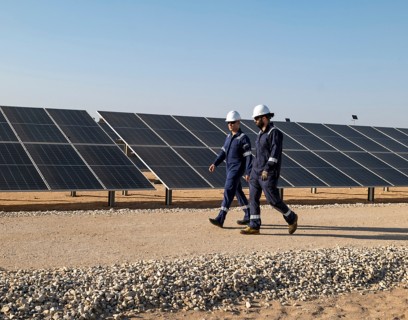
Or , our new artificial intelligence tool.
MyEni Login
- ENERGY PRODUCTS AND SOLUTIONS
Energy transition: towards increasingly decarbonised energy
We are redefining the energy mix with low-emission solutions to provide more sustainable, secure and accessible energy.

What is the energy transition?
The ongoing energy transition involves the shift towards a low or zero greenhouse gas (GHG) emission energy system, with the aim of tackling climate change caused by the use of fossil fuels. This process responds to the need for a better environmental balance and serves as a strategic driver to reshape the global model of economic and industrial development. The transition requires an evolution of the global energy mix through the integration of renewable sources, lower-emission technologies, and innovative, more efficient energy solutions.
The goals of the energy transition
The goals of the energy transition are to reduce greenhouse gas emissions while also helping to ensure and expand access to energy, in a context of growing demand driven by population growth and economic development, particularly in currently less developed countries. The United Nations’ 2030 Agenda, through SDG 7, highlights the importance of energy that is “affordable, reliable, sustainable and modern.” Eni’s approach seeks to balance environmental sustainability, energy security and economic accessibility, addressing the issue of the “energy trilemma”.
Actions to enable the energy transition
At Eni, the energy transition is seen as a process of technological and industrial transformation. Contributing to its achievement requires a long-term strategic vision grounded in innovation. Our strategy is based on the principle of technological neutrality, which means the energy transition can only be achieved by adopting a flexible approach to the technologies available to us. Rather than relying on a single solution, such as renewables alone, it involves drawing on a portfolio of technologies and selecting the most suitable option case by case, depending on its maturity and effectiveness in reducing emissions in a given context.
The energy transition: pros and cons
The main benefit of the energy transition is the reduction of greenhouse gas (GHG) emissions. However, this path also presents significant challenges, such as rising energy costs, the need to develop appropriate infrastructure and the risk of reduced energy security. Our strategy is based on an integrated approach, based on diversified energy sources and technological innovation.
Examples of energy transition
The history of humankind is marked by a series of energy transitions: from the discovery of fire to the domestication of animals, from the invention of machines powered by water and wind to the shift from wood to coal, from oil to gas, and finally to nuclear energy. Today, we are in the midst of a new transition towards a low-emission energy mix.
The energy transition and the role of natural gas
Natural gas can play a transitional role, thanks to the "coal-to-gas switch" which reduces CO2 emissions. When used as a fuel, natural gas is the fossil source with the lowest CO2 emissions per unit of energy produced: approximately half compared to coal. Furthermore, gas is an ally of renewable energy sources because, thanks to its flexibility, it makes it possible to compensate for their variability. In doing so, it enhances grid stability - something that renewables alone cannot ensure without sufficient energy storage systems. Additionally, it is possible to further reduce emissions from gas power plants by integrating carbon capture and storage (CCS) technologies. For this reason, Eni has set ambitious targets: by 2030, over 60% of its production mix will be based on natural gas, reaching over 90% by 2050.
The words of energy
A column that explains in plain words the energy that drives the world, from natural gas to renewables, from sustainable mobility to decarbonization.




















